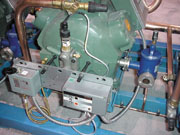

Service techs who work on these systems can improve their troubleshooting skills by paying attention to the points covered in this article.
Parallel compressor systems employ two or more compressors to a common suction header and a common discharge header (Figure 1). However, parallel compressor systems can often have oil-related problems.
One common problem is maintaining correct oil levels in each compressor. Another problem arises in separating the oil from the refrigerant in the often-oversized discharge line at partial loads.
Both of these problems will be explored in this article, along with an understanding of the complete oil system.

REDUCED LOADS
Often, only one or two compressors on the parallel rack will be running because of a decreased load in the store.This can occur in the winter, when low humidity levels decrease the latent heat loads on the refrigeration cases. It also can occur during nighttime hours, when cases are not being used as often and setback thermostats have reduced the ambient temperature by a few degrees.
At partial load, the common discharge line is often a bit oversized. This happens because of the common discharge line having to be a certain diameter when handling full-load operations with all of the compressors running. At partial load, the same-diameter discharge line now has to handle only one or two compressors.
This mismatch often causes lower refrigerant velocities in the discharge line at partial loads. Lower refrigerant velocities often relate to oil not being moved along the lines as designed.
This is one reason why the first component in the discharge line is a large oil separator (Figure 1).

VARYING LOADS
As loads vary, a pressure transducer mounted in the common suction header linked to a microprocessor turns compressors on and off in response to these changing loads. Because of this, oil return is often not equal to each compressor.Some compressors are overfilled with oil and some are underfilled. Even a slight difference in pumping rate between like-sized compressors or significant differences in pumping rates caused by different-sized compressors on parallel racks will cause uneven oil return rates to the compressors involved.
The solution to this oil problem is a sophisticated oil separation and return system that separates the oil from the refrigerant gas and keeps every compressor in the parallel rack supplied with equal amounts of oil.

OIL SEPARATOR
As the oil-laden discharge gas enters the oil separator as a fog, its velocity is immediately slowed down. This low velocity is the key to good oil separation. The refrigerant-oil fog mixture runs into external baffling, which causes the fog mixture to change directions.At the same time, the baffles cause the fog mixture to slow down rapidly. This causes very fine oil particles to collide with one another and form heavier particles. Fine-mesh screens separate the oil-and-refrigerant mixture even more, causing larger oil droplets to form and drop to the bottom of the oil separator.
When the level of the oil becomes high enough to raise a float, an oil return needle is opened and oil is sent to an oil reservoir.
The method of oil separation just described is just one scheme used in the industry.

OIL RESERVOIR
The oil reservoir is essentially a storage volume for oil while it is waiting to be transported to the compressor crankcases. The oil reservoir receives oil from the oil separator by a difference in pressure between the two components.The oil reservoir is vented to suction pressure by a reservoir pressure difference valve (Figure 4). This valve maintains a set pressure difference (5 to 20 psi) between reservoir pressure and suction pressure. This prevents oil foaming and overfeeding when the oil is to be later delivered to the compressor’s crankcase through the oil level regulators.
Oil reservoirs often have sight glasses on them to let the service technician know at a glance how much oil is in the reservoir. A large oil reservoir (large blue upright tank with sight glasses) is shown in Figure 2. In some installations, a combination oil separator-reservoir is used (Figure 3).

OIL FLOAT VALVES
From the reservoir, the oil passes through oil filters on its way to the oil float valves (Figure 5). Oil float valves, sometimes called oil level regulator valves, are mounted on each compressor at its sight glass location (Figures 6 and 7). These float-activated valves are often fully adjustable and open and close as necessary to ensure adequate oil level in the compressor crankcase.Manufacturers often use electronic oil level controllers incorporating transducers that offer oil level control, along with low-oil-level alarm capabilities (Figure 8).
Tomczyk is a professor of hvacr at Ferris State University, Big Rapids, MI.
Sidebar: Emerson’s Internet Innovations Draw Praise
Emerson Electric has been selected as one of the “Innovation 100” companies for its focus on customer service messages and customer needs.
Research teams from the newsmagazine
The report said that “Emerson Electric not only sells refrigeration equipment, but also uses the Internet to moderate the temperature of each refrigerator it sells.”
Publication date: 06/04/2001

Report Abusive Comment